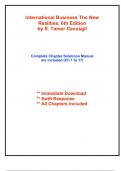International Business The New
Realities, 6th Edition
by S. Tamer Cavusgil
Complete Chapter Solutions Manual
are included (Ch 1 to 17)
** Immediate Download
** Swift Response
** All Chapters included
,Table of Contents are given below
1.Introduction: What Is International Business?
2.Globalization of Markets and the Internationalization of the
Firm
3.The Cultural Environment of International Business
4.Ethics, Corporate Social Responsibility, Sustainability, and
Governance in International Business
5.Theories of International Trade and Investment
6.Political and Legal Systems in National Environments
7.Government Intervention and Regional Economic Integration
8.Understanding Emerging Markets
9.The International Monetary and Financial Environment
10.Financial Management and Accounting in the Global Firm
11.Strategy and Organization in the International Firm
12.Global Market Opportunity Assessment
13.Exporting and Global Sourcing
14.Foreign Direct Investment and Collaborative Ventures
15.Licensing, Franchising, and Other Contractual Strategies
16.Marketing in the Global Firm
17.Human Resource Management in the Global Firm
, Solutions Manual organized in reverse order, with the last chapter
displayed first, to ensure that all chapters are included in this
document. (Complete Chapters included Ch17-1)
PART 5
FUNCTIONAL AREA EXCELLENCE
CHAPTER 17
HUMAN RESOURCE MANAGEMENT IN THE GLOBAL FIRM
Instructor’s Manual by Marta Szabo White
I. LECTURE STARTER/LAUNCHER
■ This chapter discusses the strategic role of human resources in international business.
As firms become increasingly international, and their subsidiaries span many countries
over many continents, there is a greater need for more internationally oriented
managers, and more employees from the involved countries and regions. Hiring and
retaining thousands and often hundreds of thousands of people to work at an
international firm requires tremendous skill and close coordination. It is also complicated
for a SME to hire just a few employees to work internationally.
■ Before lecturing about this chapter, one approach is to ask students to do a short
assignment. Ask them to choose a fairly large international company and find out how
many employees work at the company. By visiting company websites, students can often
find out if a company predominantly hires home country nationals, host country
nationals, or third country nationals.
■ For example, Global firms such as Siemens, Hutchison Whampoa, IBM, ArcelorMittal,
Nestlé, Matsushita, McDonald’s, Unilever, Volkswagen, and Walmart each has more
than 100,000 employees working outside their home countries.
■ Ask students to discuss the possible advantages (and disadvantages) of hiring all
three types of staff: home country, host country, and third country employees.
◘ A parent-country national (PCN) (home country) is an employee who is a
citizen of the country where the MNE is headquartered.
◘ A host-country national (HCN) is an employee who is a citizen of the country
where the MNE subsidiary or affiliate is located.
◘ A third-country national (TCN) is an employee who is a citizen of a country
other than the home or host country.
● Home country staff may bring aspects of corporate culture to the overseas
location.
● Host country employees may bring local knowledge of business practices,
markets, networks, and other relationships.
● Third country employees, who are neither from the home or host country, are
often the best professionals in the business.
, Instructor Manual Cavusgil/Knight/ Riesenberger International
6e
You may wish to write these points on the board and refer to them later as you continue
your lecture.
■ Exhibit 17.7 illustrates the percentage of workers in each country that have formal
union memberships.
■ Note the gradual decline of union membership in many economies.
◘ It has fallen to less than 17 percent of workers in Australia and Germany, and less
than 11 percent in France and the U.S.
◘ However, union membership is relatively high in Sweden, where more than 65
percent of workers, mostly government employees, are unionized.
■ Ask students to break out into small groups and discuss why union membership has
declined in many countries.
II. LEARNING OBJECTIVES AND THE OPENING VIGNETTE
LEARNING OBJECTIVES
After studying this chapter, students should be able to do the following:
17.1 Understand the strategic role of human resources in international business.
17.2 Explain international staffing policy.
17.3 Describe the process of establishing training needs and programs to help
employees perform well in international environments.
17.4 Discuss performance appraisal and compensation of international employees.
17.5 Understand international labor relations.
17.6 Discuss trends in international labor.
17.7 Describe diversity, equity, and inclusion in the international workforce.
Key Themes
■ In this chapter, there are seven themes:
[1] The Strategic Role of Human Resources in International Business
[2] International Staffing Policy
[3] Preparation and Training of International Employees
[4] Performance Appraisal and Compensation of International Employees
[5] International Labor Relations
[6] Trends in International Labor
[7] Diversity, Equity, and Inclusion in the International Workforce
■ This chapter addresses the complexities of compensating managers who work abroad,
the complex nature of international labor relations, and the value of maintaining a diverse
workforce, especially of managers with varied global experience.
2 | Page




